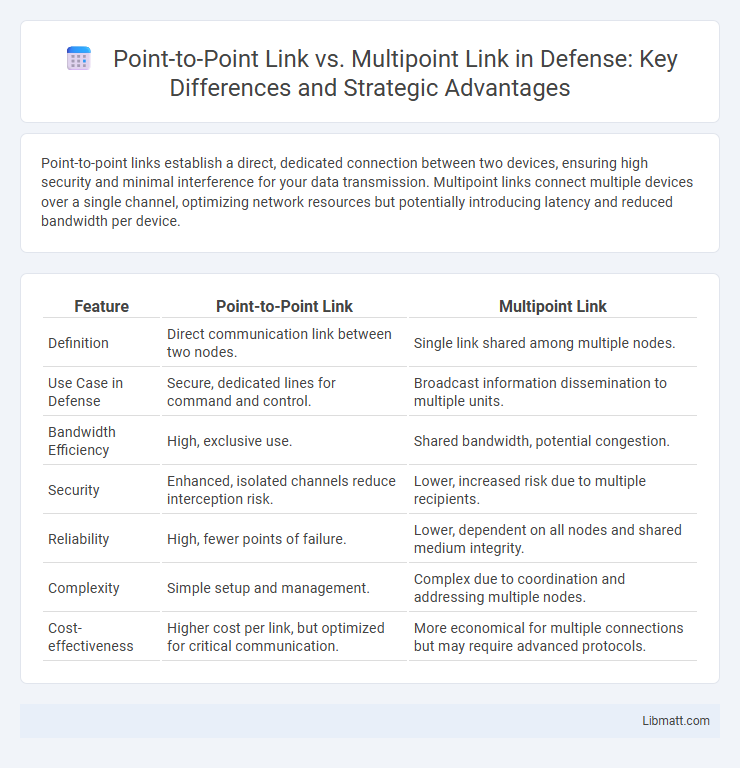Point-to-point links establish a direct, dedicated connection between two devices, ensuring high security and minimal interference for your data transmission. Multipoint links connect multiple devices over a single channel, optimizing network resources but potentially introducing latency and reduced bandwidth per device.
Table of Comparison
| Feature | Point-to-Point Link | Multipoint Link |
|---|---|---|
| Definition | Direct communication link between two nodes. | Single link shared among multiple nodes. |
| Use Case in Defense | Secure, dedicated lines for command and control. | Broadcast information dissemination to multiple units. |
| Bandwidth Efficiency | High, exclusive use. | Shared bandwidth, potential congestion. |
| Security | Enhanced, isolated channels reduce interception risk. | Lower, increased risk due to multiple recipients. |
| Reliability | High, fewer points of failure. | Lower, dependent on all nodes and shared medium integrity. |
| Complexity | Simple setup and management. | Complex due to coordination and addressing multiple nodes. |
| Cost-effectiveness | Higher cost per link, but optimized for critical communication. | More economical for multiple connections but may require advanced protocols. |
Introduction to Network Links
Point-to-point links establish a direct connection between two network nodes, ensuring dedicated bandwidth and minimal latency for your data transmission. Multipoint links, on the other hand, connect multiple nodes within a single network segment, enabling resource sharing but potentially introducing higher latency and collision domains. Understanding the distinctions between these network link types is crucial for optimizing your network's performance and scalability.
Definition of Point-to-Point Link
A point-to-point link is a direct communication channel established between exactly two network devices, enabling exclusive data transmission without interference from others. This type of link ensures dedicated bandwidth and reliable connection, optimizing performance for applications requiring secure, real-time communication. Your network benefits from minimized latency and simplified management when using point-to-point links compared to multipoint configurations.
Definition of Multipoint Link
A multipoint link is a network connection where multiple devices share the same communication channel, allowing more than two endpoints to interconnect on a single link. Unlike point-to-point links that facilitate direct communication between exactly two nodes, multipoint links support simultaneous data exchange among several nodes, often used in bus or ring topologies. This structure optimizes resource usage by reducing the number of physical connections while enabling scalable network communication.
Key Differences Between Point-to-Point and Multipoint Links
Point-to-point links establish a direct communication path between two devices, providing dedicated bandwidth and improved security, whereas multipoint links connect multiple devices over a shared medium, which can reduce costs but may introduce latency and collision risks. Point-to-point networks simplify troubleshooting and offer predictable performance, while multipoint configurations require complex management protocols to coordinate access among multiple nodes. Understanding these differences is crucial for designing efficient network topologies tailored to specific bandwidth, scalability, and latency requirements.
Advantages of Point-to-Point Links
Point-to-point links offer dedicated communication channels, ensuring higher security and consistent data transfer speeds compared to multipoint links. These connections reduce the risk of data collisions and interference, providing more reliable and stable network performance for your critical applications. Lower latency and simpler troubleshooting further enhance their efficiency in environments requiring direct device-to-device communication.
Advantages of Multipoint Links
Multipoint links offer significant advantages in network design by enabling multiple devices to share a single communication channel, which reduces cabling costs and simplifies infrastructure. They enhance scalability by allowing easy addition of new nodes without the need for extensive rewiring or additional point-to-point links. This topology also improves channel utilization efficiency in scenarios where data transmission occurs sporadically among multiple devices.
Common Use Cases for Each Link Type
Point-to-point links are commonly used for direct, dedicated connections between two devices or locations, such as connecting a branch office to a central data center or establishing a stable WAN link. Multipoint links are ideal for network environments requiring multiple devices to share a single communication channel, often found in LAN setups, conferencing systems, or wireless mesh networks. Your choice depends on whether you need exclusive bandwidth and minimal latency (point-to-point) or scalable connectivity for multiple nodes (multipoint).
Performance and Scalability Comparison
Point-to-point links offer superior performance with dedicated bandwidth between two devices, minimizing latency and ensuring consistent data transfer speeds ideal for high-demand applications. Multipoint links enable multiple devices to share a single communication channel, enhancing scalability but potentially reducing performance due to bandwidth sharing and collision domains. Your network design should consider point-to-point connections for critical, high-throughput requirements, while multipoint links suit scalable environments where resource efficiency outweighs peak performance needs.
Security Considerations
Point-to-point links offer enhanced security by creating a dedicated communication channel between two devices, minimizing exposure to unauthorized access or interception. Multipoint links share a common communication medium among multiple devices, raising risks of data leakage and eavesdropping due to the broadcast nature of transmissions. Implementing encryption protocols and robust authentication mechanisms becomes critical in multipoint configurations to mitigate vulnerabilities inherent in shared network environments.
Choosing the Right Link for Your Network
Choosing the right link for your network depends on factors such as network size, bandwidth requirements, and reliability. Point-to-point links provide dedicated connections ideal for high-speed, low-latency communication between two devices, ensuring consistent performance. Multipoint links connect multiple devices on a single shared medium, offering cost efficiency and simplified management but may introduce contention and reduced bandwidth per device.
Point-to-point link vs Multipoint link Infographic

 libmatt.com
libmatt.com